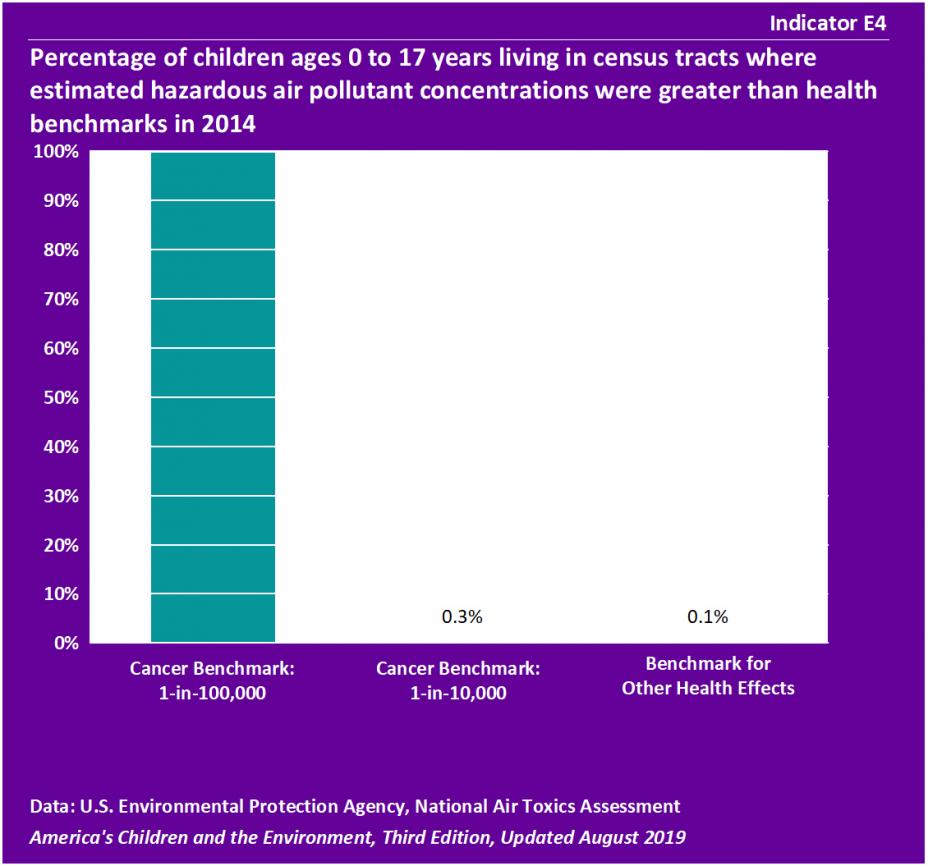ACE: Environments and Contaminants - Hazardous Air Pollutants
- Indicator E4 - Percentage of children ages 0 to 17 years living in census tracts where estimated hazardous air pollutant concentrations were greater than health benchmarks in 2014
- Background Text
- Methods
Indicator E4
![]()

Data characterization
- Data for this indicator are obtained from EPA's National Air Toxics Assessment computer model predictions of hazardous air pollutant (HAP) concentrations in outdoor air.
- The model produces estimates of HAP concentrations from emissions data for all census tracts in the United States (census tracts typically have about 4000 residents each).
- In 2014, nearly all children lived in census tracts in which HAP concentrations combined to exceed the 1-in-100,000 cancer risk benchmark.
- In 2014, 0.3 percent of children lived in census tracts in which HAPs combined to exceed the 1-in-10,000 cancer risk benchmark. The pollutants that contributed most to this result were formaldehyde, benzene, carbon tetrachloride, and acetaldehyde, Formaldehyde and benzene are considered to be carcinogenic to humans, and carbon tetrachloride and acetaldehyde are considered likely to be carcinogenic to humans.
- In 2014, 0.1 percent of children lived in census tracts in which at least one HAP exceeded the benchmark for health effects other than cancer. In almost all cases, this result was attributable to the pollutant acrolein, which is a respiratory irritant. More than 90% of acrolein emissions are from wood-burning fires and mobile sources such as cars, trucks, buses, planes, and construction equipment.
- Exposures to diesel particulate matter from diesel engine emissions are not included in this indicator due to uncertainty regarding the appropriate values to use as cancer benchmarks. Some studies have found that cancer risks from diesel particulate matter exceed those of the HAPs considered in this indicator. Although EPA does not endorse any particular cancer benchmark value for diesel particulate matter, if the State of California’s benchmark for diesel particulate matter were used in this analysis, 74% of children would live in census tracts where HAP estimates combined to exceed the 1-in-10,000 cancer risk benchmark.
- In 2014, nearly all children’s schools were located in census tracts where HAPs concentrations combined to exceed the 1-in-100,000 cancer risk benchmark. 0.3 percent of children attended schools in census tracts where the HAPs concentrations exceeded the higher 1-in-10,000 cancer risk benchmark.
- In 2014, 0.1 percent of children attended schools that were located in census tracts where at least one HAP exceeded the benchmark for health effects other than cancer.
Background Text
About the Hazardous Air Pollutants Indicator
Indicator E4 presents information about children living in areas where hazardous air pollutant (HAP) concentrations were greater than health benchmarks. The data are from a database of computer modeled predictions of HAP concentrations in outdoor air.
The Clean Air Act identifies 187 substances as HAPs such as benzene, trichloroethylene, formaldehyde, mercury, and chromium. HAPs are emitted into ambient air from a range of industrial facilities and vehicles. EPA sets federal regulations to reduce HAP emissions from these sources.
Health effects associated with HAPs include cancer, asthma and other respiratory ailments, birth defects, reproductive effects, and neurodevelopmental defects. The health effects of certain HAPs, such as benzene, chromium, nickel, and vinyl chloride, have been identified through studies of workers exposed to high levels on the job. For some HAPs, observational studies have been conducted in populations with lower exposure levels typical of the general population. For most HAPs, concerns about health effects come from laboratory animal studies.
Indicator E4 presents estimated HAP concentrations exceeding health benchmarks for children from EPA's National Air Toxics Assessment (NATA).
More information about hazardous air pollutants and Indicator E4 is provided in the Hazardous Air Pollutants section of America's Children and the Environment, Third Edition.
Related Links
U.S. EPA: About Hazardous Air Pollutants
U.S. EPA: National Air Toxics Assessments
Summary of Methods – Hazardous Air Pollutants
EPA's National Air Toxics Assessment (NATA) provides estimated concentrations of 181 Hazardous Air Pollutants (HAPs) in ambient air for the year 2014. Under NATA, EPA develops modeled estimates of ambient concentrations of HAPs using estimated emissions data from major, area, onroad mobile, and non-road mobile sources.
Indicator E4 uses the NATA data to display percentages of children ages 0 to 17 living in census tracts that have modeled concentrations of HAPs in ambient air greater than the health benchmarks for 2014. The NATA data are compared with three health benchmark concentrations derived from scientific assessments conducted by EPA and other environmental agencies. Two benchmarks reflect potential cancer risks, at levels of 1-in-100,000 risk and 1-in-10,000 risk. The third benchmark concentration corresponds to the level at which exposure to the hazardous air pollutant is estimated to be of minimal risk for adverse non-cancer health effects; exposures above this benchmark may be associated with adverse health effects such as respiratory or neurological effects.
Detailed Methods for Indicator E4
Metadata for National Air Toxics Assessment (NATA)
Metadata for Census: American Community Survey Data
